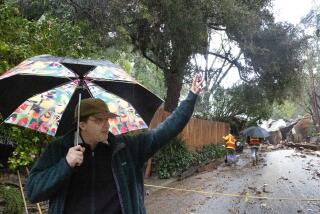Study on Arctic warmth and winter weather across the U.S. draws heated debate
Those severe winter storms that have been plaguing the East Coast might be linked to a rapidly warming Arctic, according to a new study on Arctic temperatures and extreme weather in a dozen U.S. cities.
While the findings published in the journal Nature Communications build on earlier studies that have looked into this connection, they drew criticism from other researchers who questioned some aspects of the work.
“The basic findings are sound, but I would take issue with some of the interpretation in the study,” Michael Mann, a climate scientist at Pennsylvania State University who was not involved in the study, said in an email.
The Arctic has been warming fast in recent decades, causing sea ice to shrink to record lows. This temperature rise comes as global warming, fueled by the greenhouse gases released by decades of human activity, shows little sign of slowing.
At the same time, scientists have begun to wonder whether the flurry of winter storms in the last few years might somehow be related to Arctic warming. Some work had already suggested there was a connection, but lead author Judah Cohen, an MIT climatologist with Atmospheric and Environmental Research in Lexington, Mass., wanted to see whether there was a more quantifiable, consistent link.
Cohen and his colleagues compared three different sources of data: an index of Arctic temperatures, an index that combined Arctic temperatures and surface pressures, and the Accumulated Winter Season Severity Index — which tracks extreme winter weather events by looking at such factors as maximum and minimum temperatures, snowfall and snow depth.
For this study, the researchers looked at 12 areas either in or around these cities: Seattle; Helena, Mont.; Salt Lake City; Bismarck, N.D.; Duluth, Minn.; Des Moines; Detroit; Chicago; Milton, Mass.; New York; Washington and Atlanta.
After comparing the three indices for these areas from the years 1950 to 2016, Cohen and his colleagues found a strong link between Arctic warmth and nasty winter weather, from record-breaking cold snaps to intense snowstorms. In fact, in the Eastern United States, extreme winter weather was 2 to 4 times more likely when Arctic temperatures were unusually high.
In the Western U.S., the trend was more mixed and sometimes even the opposite, reflecting somewhat milder winter weather in general.
For the paper, the scientists did not try to pin down exactly how and why this happens, and they stressed that correlation did not equal causation. Still, they did suggest that the Arctic warming could potentially contribute to rougher winter weather.
“These findings suggest that the continuation of rapid Arctic warming and melting contribute to more frequent episodes of severe winter across the [Northern Hemisphere’s] mid-latitude continents,” the authors wrote.
That suggestion of correlation was one of the reasons the paper came under fire from other climate scientists.
Mann pointed out that increased snowfall in the Northeastern U.S. and mid-Atlantic partly reflect warmer ocean temperatures and stronger coastal storms, which can produce stronger nor’easters with larger snowfall totals — like many of the storms seen this season.
“This is an entirely separate mechanism from Arctic warming,” Mann said. “This example points to the limitations in purely observationally-based studies such as this one, and the importance of investigating dynamical mechanisms with physically-based models. There isn’t just one factor at work, but many.”
Kevin Trenberth of the National Center for Atmospheric Research in Boulder, Colo., said that many parts of the paper were “not new” and others were “not right.”
“The link between the warm Arctic and cold in [the mid-latitudes] is an obvious one: the cold air has to go somewhere,” Trenberth said in an email. “The question is where and what is the cause. This study reaffirms the relationship but not its cause. The Arctic likely plays a modest role in terms of feedbacks but it is unlikely it is a cause.”
Something else might be responsible for both the Arctic warming and the extreme winter weather, he added.
The study comes as some Republican politicians have in recent years used winter weather to attempt to disprove the existence of climate change. Sen. James M. Inhofe (R-Okla.) memorably brought a snowball into the Senate in February 2015 to suggest that climate change was not real. President Trump has also suggested in the past that record-setting snowstorms and freezing temperatures contradict global warming.
But in an interview, Trenberth pointed out that the opposite is true. In the middle of winter, the temperature over the continent is usually too cold, and the air is too dry, for snow to form. But rising ocean temperatures (thanks to global warming) could inject just enough warm moisture to bring those frigid temperatures high enough (around 28 to 32 degrees Fahrenheit) for a lot of snow to fall.
“If you warm things up a bit with global warming, you actually create conditions ripe for bigger snowfalls,” he said.
Follow @aminawrite on Twitter for more science news and “like” Los Angeles Times Science & Health on Facebook.
MORE IN SCIENCE
This is ‘nanowood,’ a new invention that could greatly reduce humanity’s carbon footprint
On Twitter, fake news spreads faster and further than real news — and bots aren’t to blame







